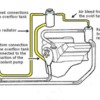OK, I know the main tank has a regular radiator cap on it.
The expansion tank on my car is old and crusty and dropping bits of rubber and shit into my cooling system. I've lined it with plastic to seal it temporarily, but I want to install the proper cap, or repair my existing cap.
My question is, Is the expansion cap a sealed cap? Or is it designed to let air in and out to acommodate the raising and lowering levels of coolant?
I was told to just use a regular radiator cap without the guts, but that leaves a small hole in the top. To me that sounds fine, the tank is just there to accept and give back the coolant that expands and contracts from heat as the engine goes through it's heat cycles.
I thought though I read somewhere that the Pantera cooling system was a closed, sealed system. In that case, the expansion tank cap should make a good seal and not let air in or out,.
So which is it?
I bought a radiator cap that I can cut the spring and lower plunger seal off of, but that leaves a small hole in the top.
I also bought some rubber "gasket maker" that I can cut a circle or 2 to fit the old cap and have it sealed (as it was before I believe.
Thanks for any help.
Original Post




